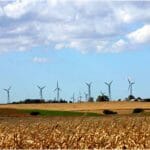Our World in 2046: Tech Mix
Practical Farmers is 30 years old. Where should our organization be 30 years from now? At a 2016 Annual Conference session, we will be exploring this very question. I thought it might be helpful to revisit a conference session we held five years back that presented some options for the Iowa agriculture of the future. How does PFI fit into these scenarios of the year 2046? Please join Tina Bakehouse, Gail Hickenbottom and me Jan. 23 with your ideas.
Scenario One: Tech Mix
Mark and Mary pull out of the parking lot, full of information from the 2046 PFI conference. It was good to see old friends in the flesh, Mary says. So often now they get updates from everyone on their hand-held devices. They have easy electronic access to any technical information they need for their farming operation as well. Still, there is not substitute for actual contact with fellow farmers, so they make the yearly trek to the PFI conference.
 As Mark pulls out onto an I-80 lined with wind turbines, he remembers their first PFI meeting in 2016. Everyone arrived in petroleum-powered cars. He shakes his head at the inefficiencies in his pickup and farm at that time. Today, he and Mary drive a battery and fuel cell vehicle, and their farm equipment has long been electric. It all runs cleanly and quietly with few breakdowns and no direct consumption of fossil fuel.
As Mark pulls out onto an I-80 lined with wind turbines, he remembers their first PFI meeting in 2016. Everyone arrived in petroleum-powered cars. He shakes his head at the inefficiencies in his pickup and farm at that time. Today, he and Mary drive a battery and fuel cell vehicle, and their farm equipment has long been electric. It all runs cleanly and quietly with few breakdowns and no direct consumption of fossil fuel.
And it’s a good thing too—without the efficiency increases of the last couple decades, he’d have trouble running his 5,000-acre corn and soybean operation.
Mary cares for their two children, who help her with the farm’s 5,000 head farrow-to-finish hog operation (which is smell-free and complete with a methane digester that heats and cools their home). In 2016, she didn’t use the Internet all that much; today her virtually paperless world includes home-schooling on-line, as there are few schools nearby. The school materials she finds are first-rate; she uses neighborhood clubs and church for socializing the children.
The family grows its own fresh produce, and they eat their own pork. But most of her food dollar is spent through an online regional food ordering system. Mary enjoys reviewing the on-line data about the farms and their food emissions, emissions that have been carefully calculated down to the type of soil used to grow the food. She recalls the days when words like “natural” were slapped on to products with few standards and little science backing up the food claims.
Like everyone else at the conference, Mark and Mary are being hit with droughts followed by intense rains every other year. “Weird weather,” everyone called it back in 2016, but it is now considered the norm. The corn and soybean seed of 2016 couldn’t have handled this volatility; yet year to year Mark’s losses have been mitigated by planting a mix of drought- and flood-tolerant corn and soybean seed. His corn gets an average of 220 bushels an acre during good years; his soybeans 75. He and Mary pay dearly for that seed, but they also have to admit that Monsanto’s research power has really paid off in yields.
Weeds, though, have long worried both of them. Despite the steadily improved “stacked” seed that Monsanto has sold through the years, the weeds are “winning” and require additional labor to control them. “We’ve got all of this technology,” Mark told a fellow farmer at the conference, “yet we’re back to hiring kids to walk corn and beans,” just like they did 50 years ago.
Mark and Mary turn off the Interstate at the Williamsburg exit. They agree the 30 years since their first PFI conference have been ones of rapid technological change. In general, they have the life they want. We’re lucky, Mark thinks. Over all, we have time for our children, steady income, and the lifestyle we want.
